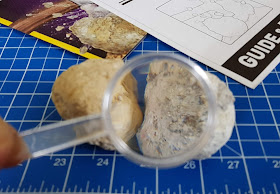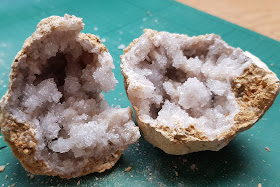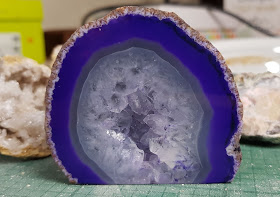Excitingly National Geographic sets now come with cardboard inserts and plastic is kept to a bare minimum. There's no set up time and you can crack open your Geode as soon as you have located a hammer, so Earth and Christmas morning-friendly.
The National Geographic Break Open 2 Geodes Set includes 2 geodes, plus essential safety goggles, learning guide and even a display stand for your favourite discovery. There's also every young explorer's essential - a magnifying glass.
The fun with geodes is cracking them open! The best way to do this is with a hammer and chisel, because you want to split the rock apart, but not shatter it. You do need to use some force, but start off tapping gently. If you hit too hard or in too many places, the rock will collapse into a million pieces. This has never happened to me, but I dread the day it does.
Don't forget your safety glasses, and if you want to be extra careful or young children are watching, put the geode inside a sock before you hit it. Dust and larger pieces of rock will likely come loose and can fly anywhere nearby.
We didn't have a chisel and you can simply tap the geode directly with the hammer, but we were hoping for a cleaner cut, so used a sacrificial dinner knife. The knife will be completely ruined, so an old rusty one is best and for goodness sake get permission from a responsible adult. Some metals spark when hit together, so if you try this do it well away from anything that can catch fire.
After starting out gently, these turned out to be the hardest geodes I've ever encountered. Our first geode took us about 15 minutes to crack and is very pretty. It's well filled with white crystals in a sort of cloud formation.
Our second geode really was 'rock solid'! After 30 minutes our hammer blows were really taking a lot of effort and the boys passed the challenge on to me. I had to have a few really good swings before it opened, and then we saw why. Our geode was almost completely solid.
Most geodes are created in the air gaps in volcanic rocks. Rainwater brings in chemicals that seep into the spaces, but they are safely encased and completely undisturbed. Over time, the chemicals create crystals and the geode is formed.
The biggest agate geodes can be metres tall and a hundred million years in the making! I already had my own shop-bought polished quartz geode, it's not quite so big though and if I'm truly honest, I prefer the rough finish and surprise element when you crack them open yourself...
The included booklet is excellent and tells us that our first geode is quartz, and our second has some quartz and possibly agate. If it was entirely solid it would officially be called a nodule rather than a geode, but it's formed in exactly the same way.
The National Geographic Break Open 2 Geodes Set is available to buy now priced £9.99rrp from all good toy shops instore and online, including Amazon(*aff). You can check out the entire National Geographic range on the Bandai Nat Geo web pages - there are lots of different sets to explore.
Last month we reviewed two of the National Geographic Dig Kits - Real Bugs and Dino Fossils. Both sets contain genuine scientific specimens.
We were sent our Geodes science set for review. *Amazon links are affiliate, which never costs you a penny more, but earns me a few pence if you buy through my link as a thank you for adding it.














What a fantastic kit and certainly something to keep kids... and adults entertained for a while. Some serious effort required there to get it open, but look at the end result, how fabulous! :) Sim x
ReplyDeleteExtremely disappointing. All of our geodes were exactly the same. ☹️
ReplyDeleteThat really is disappointing. Nature can be cruel at times. I can only suggest you try again, but in my experience they are mainly white quartz, it's a rare day you find others in children's kits. You can always grow your own? I love doing that, and they'll creep out of the jar and all along the shelf if you give them 2 or 3 years :D
DeleteAre they natural geodes or were they grown in a lab?
ReplyDeleteAs far as I'm aware you can't grow them inside rocks like that purposefully, so natural. They're fully enclosed and very varied as to thickness of rock and amount of crystals inside, whereas if they were grown to order they'd be more regular and not inside actual rock. Some barely have any actual crystals and are hellish to open, but others are thinner walled.
Delete